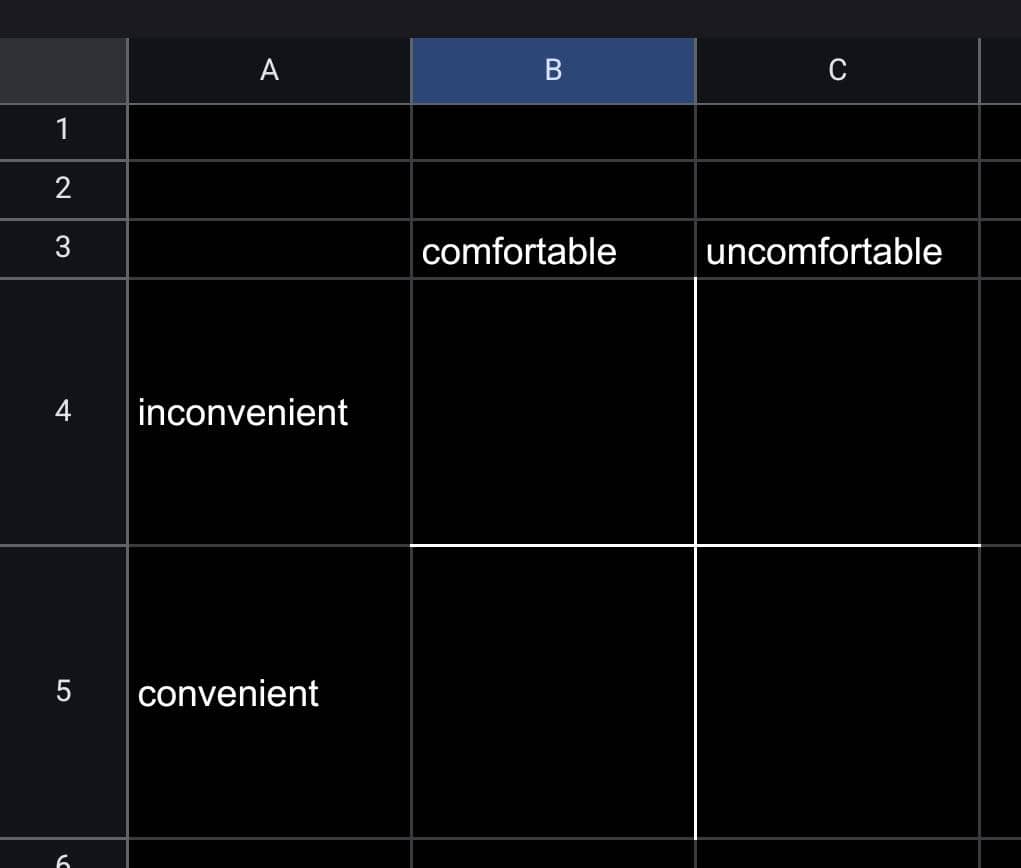Over pizza at La Taverna, Daisy and I were catching up – as friends do. We danced around many topics and then briefly discussed doing uncomfortable and inconvenient things for the people we love. She likened the phenomenon to an aspect of a comfort-convenience graph and since I got the drift of what she was saying (thank you Mathematics 101) we pretty much moved on to whatever was next on our free-floating agenda.
However, the next day I couldn’t shake the thought “If there’s something in the upper left quadrant of this comfort-convenience graph, what would the other quadrants be?”
So, I got to sketching.

Then I realised I needed working definitions for convenience and comfort.
convenience
/kənˈviːnɪəns/
noun
being able to proceed with something without difficulty
comfort
/ˈkʌmfət/
noun
physical ease and freedom from pain or constraint.
Off the bat, I knew the phenomenon Daisy described – uncomfortable and inconvenient things – was SACRIFICE.


The comfortable and convenient things are fun and leisurely so they’d be a DELIGHT to do.
Then things that are comfortable to do but inconvenient go in the DUTY quadrant.


And finally, things that are uncomfortable but convenient do to e.g favours go in the GIFT quadrant.
I also think Duty and Gift are interchangeable depending on how you feel about it all. My working theory is that every action in life and love will fit into one of these four quadrants.

My friends (Toki and Tomisin – they helped to flesh this out too!) suggested that this could be a good couples exercise. I agree too – I think it is very helpful to see how your expectations, wants and asks are viewed by your partner, spouse, lover, friends, and even family (AND VICE VERSA). So, here it goes!
The Love Quadrants Exercise
Required:
- Partner A
- Partner B
- 2 x Pens / Pencils / Crayons
- 2 x Love Quadrants worksheet.
Instructions:
- Partners A and B write down their “asks” i.e. the things they want their partners to do for/with them.
- Partner A then takes each “ask” written by Partner B and puts them in the different quadrants on the Love Quadrants worksheet based on the comfort-convenience level it is for them.
- Partner B does the same with “asks” written by Partner A .
- After sorting the “asks”, Partner A&B then label each quadrant in the worksheet.
Top left: GIFT
Top right: SACRIFICE
Bottom left: DELIGHT
Bottom right: DUTY
- Partners A&B then discuss their results e.g. expectations, assumptions, reasonings, surprises, differences, similarities, and learnings.
I have provided a list of generic asks – to get the conversation going but it’s not designed to be exhaustive – the aim is for the asks to be specific to you and your partner – no one person’s needs are the same. The aim is to explore things that are important to you and your partner; the exercise should create an avenue for transparency, communication, and understanding your partner that bit more.




